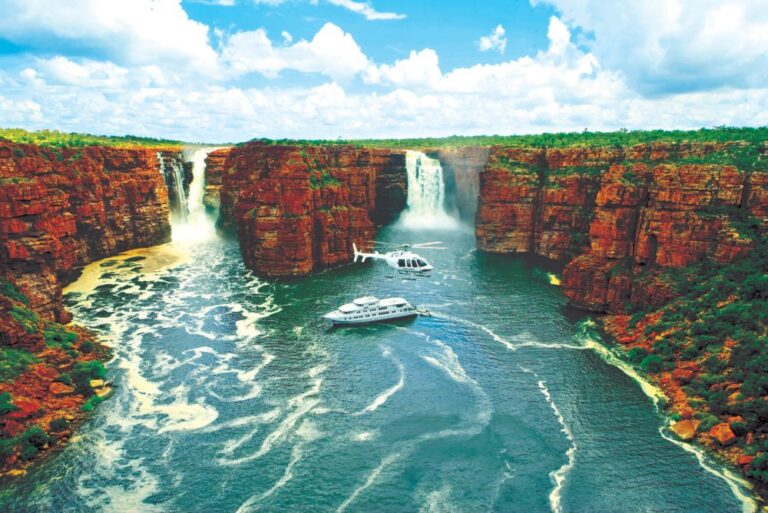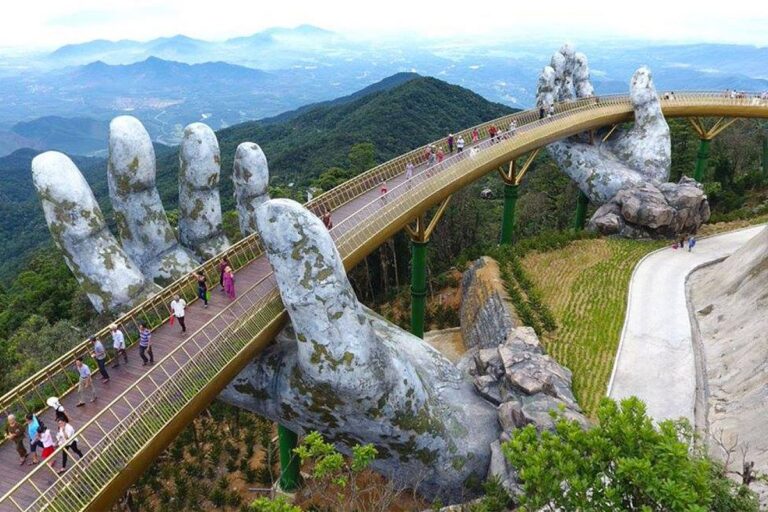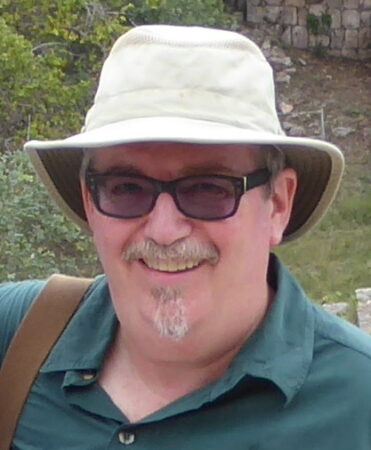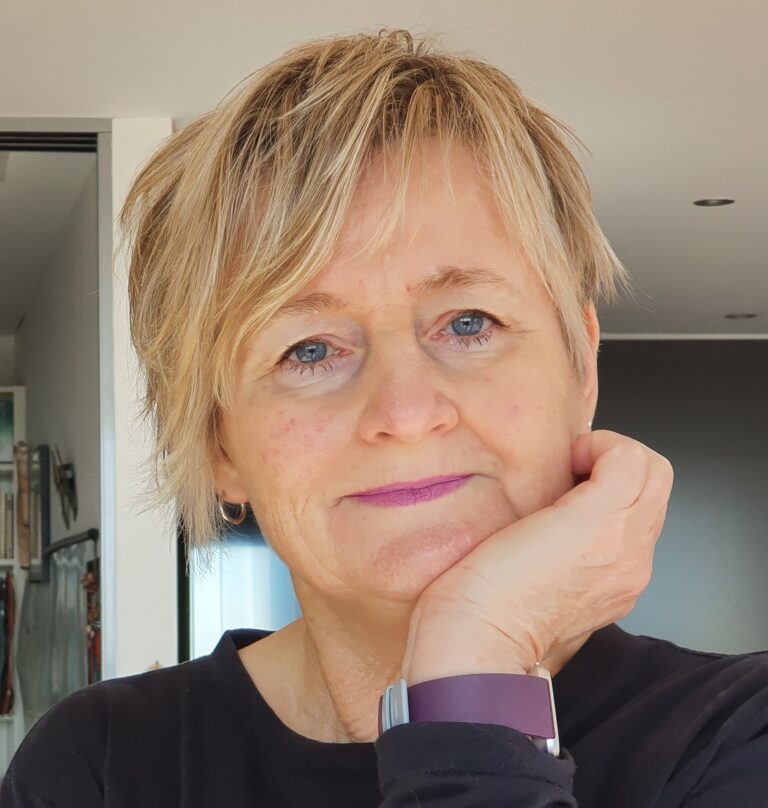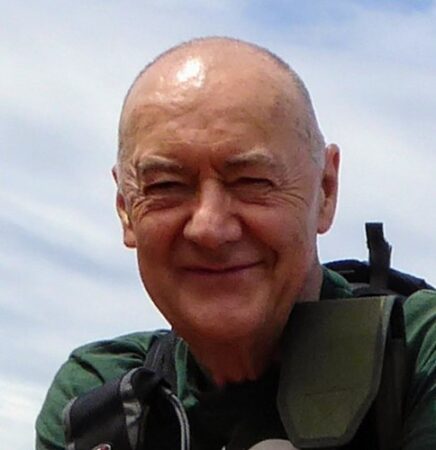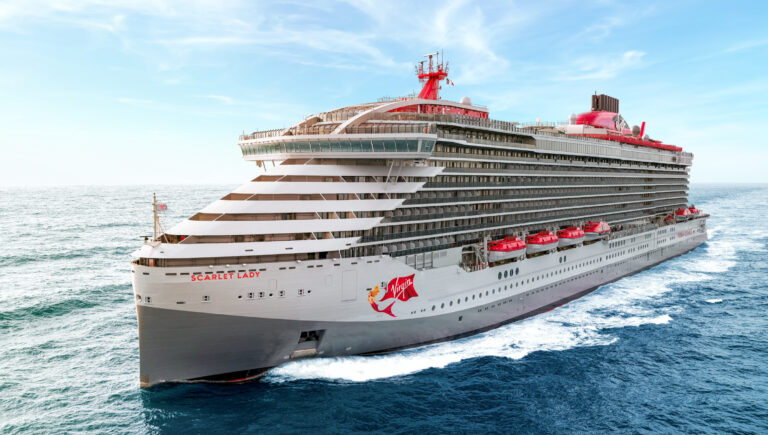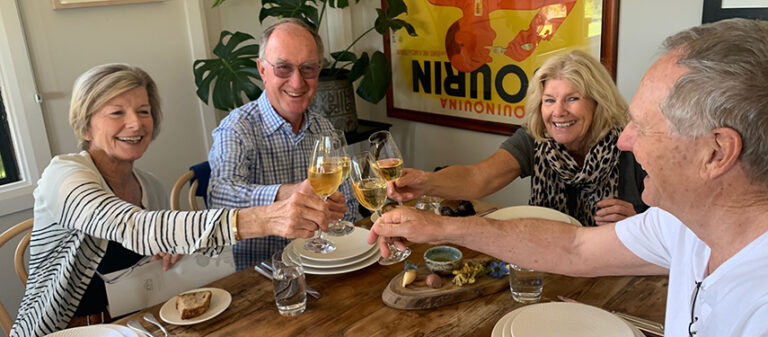It’s a blistering hot morning in Western Australia’s Kimberley region and the magnificent King Frederick Gorge is a shimmering azure.
“I could really just jump straight in,” muses the woman next to me on the rubber zodiac boat taking us from our cruise mother ship for a leisurely meander down the river.
There’s a murmur of agreement from the other seven passengers on board until our expedition leader Mick Fogg, on the boat’s tiller, overhears. “Please don’t!” he implores. “It might look lovely, but you won’t last long.”
After all, he is taking us on a hunt to photograph saltwater crocodiles and, presumably, there’d be no surer guarantee of a fabulous action shot than when someone takes a quick dip – and a hypercarnivorous apex predator looms up in search of breakfast.
A few minutes later, we see exactly what he means. A three-metre-long croc is lying lazily on a rock ledge sunning itself, but keeping an eye open for a passing snack.
Two crocs later, the no-swimming rule is underlined. A dead croc is floating in the water as an opportunistic tawny nurse shark suddenly swims up to tear strips off its corpse. This sure is nature, red in tooth and claw.
We’re on an 11-day Darwin-to-Broome Traveller – APT small ship cruise of one of the last great wildernesses on earth, along with Antarctica, the Arctic and Canada’s Boreal Forest. The Kimberley, however, has a definite edge in that it’s warm, incredibly varied and it’s in our own backyard.
And those thousands upon thousands of saltwater crocs have become the unofficial guardians of the stunning 2,000km of raw coastline, teeming with wildlife and dotted with islands, reefs, waterfalls and ancient Aboriginal rock art sites.
“Can you imagine all the hotels and resorts that would want to set up here if you could sit safely on the beach and swim in the water?” asks naturalist Jamie Van Egmond, gesturing at the white sand and crystal clear ocean framed by the towering golden cliffs. “In some ways, we should be grateful to them …”
Besides, while there’s water, water all around and not a drop to swim in, there is a natural – and blissfully croc-free – rock pool at the top of the Mitchell Falls and, for the truly faint-hearted, there’s always the pool back on the ship …
DAY ONE: DARWIN
Before boarding we explore Darwin and its fascinating war history sites – it was the target of the largest single attack ever mounted by an enemy on mainland Australia – with local war historian Dr Tom Lewis.
Then we finish with an amazing lunch at Hanuman, the only one-hatted restaurant in the Northern Territory, and a Q & A with its enterprising founder Jimmy Shu, who arrived from Sri Lanka with $50 in his pocket, the day before Cyclone Tracy hit in 1974.
Our French ship, L’Austral, has 220 passengers on board and an astonishing 144 crew; just over a 1.5 guests to each worker we quickly calculate. They include no fewer than 13 expert marine environmentalists, geologists and wildlife specialists so each of the 12 zodiacs that’ll be going out exploring each day will have an expert at the helm.
Dinner is served in the two restaurants, the casual buffet on deck 6 and the formal a la carte dining room on deck 2. Later there’s live music and the documentary Planet Ocean to keep everyone entertained.
DAY TWO: THE KIMBERLEY
This is our only full day spent on the ship as we make our way into the Kimberley and a series of lectures lets us know what’s in store. The Kimberley, we learn, is a 424,000 square kilometre wonderland of nature. Three times larger than England, it has burnished ochre cliffs with some rock slabs up to 1.82 billion years old – predating even fossils – and the most ancient art galleries on earth, containing Aboriginal drawings five times older than Egypt’s pyramids.
Moreover, we’ll be in one of the most sparsely populated places on the globe; there are only 39,000 locals in the Kimberley, or one person for every 11 square kilometres.
Yet while it’s Australia’s most rugged frontier country, it’s suddenly accessible in a small ship, with a fleet of zodiacs, or rubber duckies as they’re affectionately known, to take us through the winding channels, under the waterfalls, up to the reefs and landing us on beaches that, with 18-metre tides, some of the highest ever recorded, can quickly disappear.
“This trip has been on my bucket list since I was at school,” Melburnian Peter, 65, confides. “I can’t believe I’m now actually here. I’ve travelled all over the world, but I feel like I’ve saved the best for last.”
DAY THREE – KING GEORGE RIVER
Peter has a hangover, thanks to his fair share of champagne at the gala dinner the previous night, but he’s still thrilled to be here, he says. Looking out over the 80-metre cliffs that line the gorge we’re heading for, with giant rocks teetering on their edges, I feel exactly the same.
We decamp in the early morning into a flotilla of zodiacs, each helmed by a naturalist and then idle up the startlingly blue slice of river, admiring the weathered Warton sandstone that seems to change colour from orange to yellow to scarlet and purple as the light changes with the day.
In a fork of one tree jutting out from the cliff is a massive osprey nest, made up of sticks and torn off branches. It’s quite likely to be the same nest as was noted in the diaries of some of the early Dutch explorers of the coast since the nests service many, many generations.
As well as the ospreys swooping, there are eastern beekeepers and oyster catchers darting around above the mangroves, while shy sea turtles pop their heads up, brightly-coloured crabs scuttle around the rocks on beaches and there’s a glimpse of a dugong, peering at us before diving back down.
We finally chug up to the King George Twin Falls, the highest single-drop waterfalls in Western Australia, which featured most memorably in Baz Luhrmann’s movie Australia. At the top, we can see the tiny figures of those on the ship who’d left earlier, opting for the six-hour hike to the top of the falls.
But our helmsman today, Jamie Van Egmond, doesn’t let us wallow in the guilt. “Anyone fancy experiencing what it’s like underneath?” she asks. Enthusiastically, everyone nods and she steers the zodiac into the rainbow shining across the falls and under the pummelling water.
There are shrieks at the chill of the water as everyone laughs, until we see another zodiac nearby. The driver of that one waves us over. He’s holding a tray of glasses of even chillier champagne …
DAY FOUR – VANSITTART BAY
The ship travels overnight so we wake each morning to a new vista, and a fresh set of attractions to visit. Today, it’s the turn of Jar Island, at the southern end of Vansittart Bay, named after traders’ pottery discovered here.
We land by zodiac on the picturesque little island whose size belies its fame. It’s legendary for the Gwion Gwion-style Aboriginal art painted in ochre on the ceiling and walls of a cave at the top of a rocky outcrop of the King Leopold sandstone. Thought to date back at least 30,000 years, they are considered the oldest detailed depiction of human figures in the world. By comparison, the artworks found in Egypt’s pyramids are a mere 4,500 year old.
There’s rather more recent history further along the coast: Koolama Bay, where the merchant vessel Koolama was bombed by the Japanese during World War II. There’s a movie on board that describes the mutiny when the captain and first officer disagreed on whether to refloat the beached ship – or abandon it. Seeing the desolate area it’s not hard to imagine the desperation of the crew.
That’s equally true for our next shore expedition, this time across mudflats to view the wreckage of the C53 aircraft that crash-landed in 1942. The six passengers and crew, happily, all survived and, despite fearing they’d be attacked by the Japanese, were found and rescued four days later by a Qantas flying boat. The almost intact body of the plane, buried deep in a tangle of savannah bushland and Pandanus palms, is an eerie sight, and inspires much talk of the TV show about the survivors of a plane crash, Lost.
DAY FIVE – BIGGE ISLAND
Bigge Island is … pretty big. It’s also ruggedly interesting with beautiful pale beaches, plenty of weathered sandstone and dolerites, and its most thrilling possession – Aboriginal rock art of the Wandjina and contact style sprinkled over many sites.
We visit three galleries, all hidden from the casual observer high in the hillsides. Each is more spectacular, and breathtaking, than the last.
Back on the ship, there’s plenty to do. There are lectures from Mick Fogg, the expedition leader, or his naturalists, talks from Darwin historian Dr Tom Lewis and maritime expert Captain Peter Martin, and presentations (by yours truly) on the Australian outback and travel writing. In between there are documentaries about some of the places we’re visiting.
By way of lighter entertainment, there are chocolate, wine and cake-tastings, Spanish lessons, fashion parades, recitals by the ship’s extraordinarily talented young pianist Roman Basiuk, music sessions and workshops on everything from origami to cooking, and dance shows, dance lessons and dancing itself.
Before dinner every evening – in either of the restaurants or with a series of ‘hosted’ meals by the captain, his officers and special guests – there’s a briefing about what we’ve just done, and an outline of what the next day holds for us. It’s a great idea, and there’s barely a seat free in the theatre whenever it takes place.
DAY SIX – PRINCE FREDERICK HARBOUR
At the southern end of the York Sound, this harbour opens directly into the Indian Ocean, at the end of the Hunter River. As we take an early morning zodiac ride, the river’s bathed in a golden light reflected off the cliffs as long-beaked Corellas and white-bellied sea eagles drift through the sky, fruit bats bicker in the trees, the mangroves on the banks rustle in the breeze and crocs slip soundlessly from the mud into the water.
Peter’s back in my zodiac and I ask him if the trip is living up to his expectations. “Oh, far beyond them!” he replies as tiny silver garfish dance across the surface. “I can’t believe how magical it is.” His face suddenly freezes and I look behind me to see that aforementioned tawny nurse shark savaging the body of a dead croc. “And in other ways,” Peter continues, swallowing hard at the gruesome sight, “it’s most unexpected …”
Naturalist Josh Coates isn’t exactly reassuring. He talks about the enormous power crocs have in their tails and their jaws, how they can actually differentiate between humans and about the fact they have they have such exceptional memories, everyone should always vary their routine anywhere near them.
“They’re cold-bloodied killers with personality,” he says admiringly. “They can dive for up to two hours by slowing their heart rate and restricting their blood flow …” Peter spends the rest of the ride looking around anxiously.
Later that day, we set off again in a different zodiac to a nearby beach, where we’re picked up by helicopters to be whisked over the incredible wide landscapes of the Kimberley for a dazzling 25 minutes before reaching the Mitchell Falls, a stunning four-tiered waterfall.
There, we disembark and explore the escarpment with its tremendous views of the falls rushing down the red rocks into the oasis of blue-green water beneath. Nearby there’s a croc-free rock pool of fresh water for a welcome swim, before the equally thrilling flight back to the ship.
DAY SEVEN – MONTGOMERY REEF/RAFT POINT
Today we see one of Australia’s great natural wonders – a gigantic reef of around 400sqkm which becomes partially submerged by massive 10-metre tides then emerges as a never-never land of cascading curtain waterfalls, whirlpools, lagoons, mangroves and all manner of water creatures.
The scene of more shipwrecks than anyone really knows and, with still most of its bulk uncharted, this truly awe-inspiring phenomenon is not found anywhere else in the world. “It actually is the last frontier,” says today’s zodiac guide wildlife expert Tim Harvey. “But it’s probably much more dangerous for the wildlife. So much of it is marooned when the tide goes out, and ready to be picked off by predators.”
Afterwards, at Raft Point, we land on an island and receive a welcome from the local Aboriginal custodians, who paint ochre on our faces and give us permission to hike up to another Aboriginal rock art gallery. The paintings here have been touched up over the years by the descendants of the first families and offer a stunning insight into an ancient land and precious way of life.
DAY EIGHT – TALBOT BAY
British naturalist Sir David Attenborough once visited this place, and declared its horizontal falls as “one of the greatest wonders of the natural world.” I’m not going to argue.
With Cyclone Creek’s dramatic cliffs soaring up to 110 metres high and huge tides, there are two narrow breaks in the 1.9-billion-years-old McLarty Range where, when the tide turns, seawater on one side can’t flow quickly enough to match the rise or fall, creating a four-metre-high waterfall. As we marvel at a million litres of water per second pouring through the gap, as a rock wallaby hops up the river bank, a massive wedge-tailed eagle searches for breakfast and a hammerhead shark circles hopefully.
Then, as the tide falls, we pile into a high-powered fast boat– this time to squeeze through the seven-metre gap and ride the furious surge. I can see Peter’s knuckles are white on the back of the chair in front and a few women scream at the top of their lungs.
DAY NINE – FRESHWATER COVE/LANGGI
Freshwater Cove is a treasured place for the Worrorra people and we’re again welcomed on to their land with a ceremony. There’s a beautiful fine white sand beach and then a picturesque walk – and scramble – to more rock art galleries. On our way back, a smoking ceremony makes sure we don’t take any evil spirits back with us.
A number of passengers buy artworks direct from the people who made them. “This is something that will always remind me of a very special place,” declares one woman. “I can’t think of a better memento.”
Later, we take the zodiacs through a maze of three-metre-high sandstone pillars that locals believe are warriors killed in a great battle at the time of the world’s creation. They look eerily like the terracotta warriors of China – except that ours are much, much older.
DAY TEN – BUCCANEER ARCHIPELAGO
The final day of our cruise is spent zipping around a few of the 800 islands off the coast, at the head of King Sound. Here the mangrove-fringed islands are weathered by tides that rise by as much as 12 metres.
An almost dream-like silence falls over us all as we drift on the currents back and forwards in time.
Life snaps back into the 21st Century, however, as soon as we board the ship for the last time. There’s farewell cocktails with the captain and his crew, a gala dinner, dancing and a Parisian Moulin Rouge-style show.
DAY ELEVEN – BROOME
It’s hard to leave the ship, but it’s time for a tour of Broome, a corrugated iron town set on one of the world’s most beautiful strands, Cable Beach, and a final lunch at the Cable Beach Resort.
“So what’s the final verdict?” I ask Peter. He shakes his head. “That was magnificent,” he says finally. “Just incredible. But I really wouldn’t mind doing it all over again …”
END NOTES: YOUR CAPTAIN SPEAKING
The dashing young French Ponant captain Erwann Le Rouzic walks down the steps during the L’Austral’s welcome cocktails function, dressed in dazzling white to the rousing strains of Pirates of the Caribbean.
He has an aura of stardom around him, and the kind of genuine charisma that An Officer and A Gentleman’s Richard Gere could only attempt to imitate.
“Ah, but this is showbusiness,” he says later in his soft French accent, sitting in his office on deck four of the ship. “We like to have a bit of fun. Being the captain of a cruise ship is a little bit more glamorous than being a bus driver, but we like to play.”
And the passengers certainly respond. They quickly form a queue stretching way back down the corridor to have a photo taken with him.
“We just love having Australians on board,” says Le Rouzic, 46. “They like to have fun and they are curious about the world and have a very positive view of the world around them.
“For me, the most difficult passengers are the French, Italians and Americans. They can be a bit too picky and don’t always enjoy what they see and forget they are on vacation.”
Le Rouzic has plenty of experience of all nationalities during his 12 years captaining cruise ships visiting the Kimberley, Antarctica, Alaska, Japan and the Baltics.
He adores Antarctica but the Kimberley comes very close. “I love cruising the Kimberley as the scenery is really breathtaking; it’s beautiful,” he says.
“Then you have the indigenous people who are very, very interesting and, like Antarctica, you have the wildlife. But it is easier to get closer to penguins than it is to crocodiles …”
TRIPNOTES
BOOK
Berths are in short supply for this year’s cruises but bookings have opened for next year (2023). Check the APT Kimberley Cruising website or phone 1300 336 932; See aptouring.com.au for the company’s other tours and cruises.
FLY
Qantas, Virgin and Jetstar fly to Darwin or, for cruises in the other direction, Broome to Darwin, Qantas and Virgin fly to Broome.
Sue Williams travelled courtesy of APT and Traveller
The Covid-19 pandemic wreaked havoc on the travel industry in 2020-21. Many features on these pages were written before everything shut down but have been updated to include 2022 prices and conditions.
